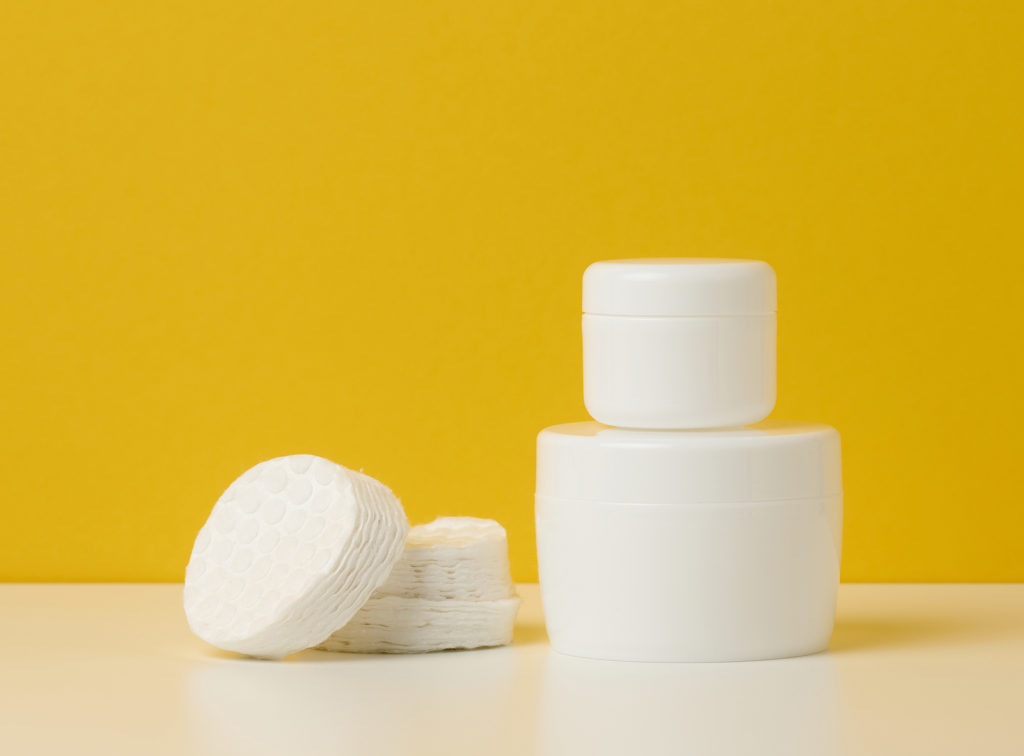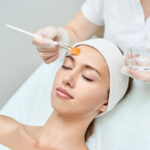
Acne Face Pads
Formulations: Salicylic Acid 2%, Sulfacetamide 5%, Clindamycin 0.5% Face Pads
Description
These face pads help remove dead skin cells and clear acne breakouts. Sulfacetamide and clindamycin help reduce breakouts by clearing acne-causing bacteria. By combining salicylic acid and these antibacterial ingredients, current break outs can be stopped and future break outs prevented. These pads can be used on a daily basis.
Cleansing pads not only wipe away dirt, make-up, and other skin contaminants – when they are medicated they also help fight bacteria and acne formation. Depending on the ingredients, face pads can help calm inflammation, reduce the prevalence of acne-causing bacteria, and improve skin tone.
Our cleansing pads for acne include a combination of treatments for reducing inflammation and bacteria. A beta-hydroxy acid, a sulfonic antibiotic, and a lincosamide antibiotic are combined in a medicated solution that is applied to the face with a cleansing pad. This can help reduce the incidence of acne breakouts while clearing current breakouts.
What is Acne?
Acne is an inflammatory skin condition that can result from a few different causes. The most important factors are increased sebum production by hyperactive glands and blocked follicles. When follicles become blocked with sebum, oil, dirt, and dead skin cells they can cause inflammation and also provide an ideal environment for acne bacteria to grow. The primary bacterium responsible for acne formation is Propionibacterium acnes, a rod-shaped Gram-positive and aerotolerant anaerobic bacterium. Acne can involve both inflammatory lesions and non-inflammatory lesions. Inflammatory lesions can include pustules, papules, nodules, abscesses, and cysts.
Acne is not just a “cosmetic” condition. In addition to the fact that it can disfigure the face and lead to permanent scarring, acne also can lead to depression, anxiety, and stress. For many patients it is a serious issue and it is in fact a medical issue not just a cosmetic one.
What are the Ingredients in this Formulation?
Salicylic Acid: A beta-hydroxy acid that has both anti-inflammatory and anti-bacterial properties.
Sulfacetamide: Numerous foams, shampoos, creams, and more exist that contain sulfacetamide. It is approved for the treatment of acne as well as seborrhoeic dermatitis.
Clindamycin: An antibiotic used to treat infections throughout the body as well as the face. The main cause of acne is bacterial growth that infects clogged pores.
How Do These Ingredients Work?
Salicylic Acid
Research has shown that the addition of salicylic acid to an antibiotic treatment provides significantly better and faster results than an antibiotic treatment used alone. The combination is warranted because no single ingredient has been shown to treat all aspects of acne. Acne fighting ingredients can be classified as comedolytic or non-comedolytic. A comedone is blockage of a pore due to it containing too much oil, dirt, and dead skin cells. A drug like clindamycin is non-comedolytic – which means that it does not unblock the pores of the face. Destroying the blockages that are causing acne is essential to clearing out a current breakout. Preventing blockages is important to preventing future breakouts. Salicylic acid has comedolytic effects as well as keratolytic effects. This means it helps destroy blockages in the skin and also helps remove dead skin cells to increase skin cell turnover. As the product works over time, blockages are reduced and prevented and new skin cells are allowed to grow that may decrease the appearance of blemishes.
Salicylic acid breaks down the follicular plugs and dissolves the intracellular “cement” that holds skin cells together. Salicylic acid is lipophilic, which means it is able to penetrate lipid membranes of the skin.
It is important to note that the new skin that grows after exfoliation with salicylic acid is extremely sensitive to UV radiation. Proper sun protection is essential to prevent further skin damage from sun exposure. This may include wearing a broad spectrum SPF 30+ sunscreen, sun protection like a broad-brimmed-hat, and seeking shade at the hours of the day when the sun is strongest.
Side effects from salicylic acid have been shown to be most obvious during the first two weeks after initiating treatment. The frequency and severity of side effects decreases with continued use. In most cases the side effects are mild and go away in a short amount of time. The most frequently reported side effect is skin dryness, which can occur in up to two thirds of patients.
Sulfacetamide
Sulfacetamide is a sulfonamide (aka “sulfa”) antibiotic that is active against gram-positive and gram-negative bacteria and works by restricting the production of folic acid (important for the growth of bacteria). It has been used in combination with sulfur for decades to treat acne, seborrheic dermatitis, rosacea, and other skin conditions. Its antibacterial activity is the main reason it is used to treat acne however it also has anti-inflammatory properties.
This drug is contraindicated in patients with sulfa allergies. Itching and redness are the two most common side effects however in general sulfacetamide is well tolerated when used topically to treat acne.
Clindamycin
Clindamycin is a widely prescribed antibiotic and often the first line treatment for acne. It has been prescribed to treat acne for decades and is still frequently prescribed. This drug inhibits bacterial protein synthesis and thus reduces the prevalence of P. acnes in the sebaceous follicle. Specifically clindamycin is useful for treating inflammatory lesions but not as effective at treating comedones (like blackheads). However when combined with other ingredients like salicylic acid or benzoyl peroxide it may be more effective. Similar to sulfacetamide, this drug both destroys acne-causing bacteria and also reduces inflammation.
This drug actually has numerous uses in treating infections in other parts of the body including lower respiratory infections, gynecological infections, joint infections, and more. It is on the World Health Organization’s list of essential medicines and is commonly prescribed in the U.S. (over 5 million prescriptions annually). Usually clindamycin has few side effects when used for treating acne however it should be used with caution in patients with gastrointestinal conditions as there is a risk of Clostridium difficile overgrowth. It is a pregnancy category B risk – short term use is safe during pregnancy.
Citations
- Efficacy of the addition of salicylic acid to clindamycin and benzoyl peroxide combination for acne vulgaris – The Journal of Dermatology
- Use of organic acids in acne and skin discolorations therapy – Advances in Hygiene and Experimental Medicine
- ACNE VULGARIS—Evaluation of a Medicated Cleansing Pad – Western Journal of Medicine
- Topical azelaic acid, salicylic acid, nicotinamide, sulphur, zinc and fruit acid (alpha‐hydroxy acid) for acne – Cochrane Library
- An update on the management of acne vulgaris – Clinical, Cosmetic, and Investigative Dermatology
- The Use of Sodium Sulfacetamide 10%-Sulfur 5% Emollient Foam in the Treatment of Acne Vulgaris – Journal of Clinical and Aesthetic Dermatology
- Diagnosis and Treatment of Acne – American Family Physician
- The Use of Sodium Sulfacetamide in Dermatology – MDEdge
- Effects of topical clindamycin on intestinal microflora in patients with acne – Journal of the American Academy of Dermatology
- Clindamycin – StatPearls
Order Clear Face Pads
Question about clear face pads? Reach out to us today:
Related Articles
- Low Dose Naltrexone for Crohn’s Disease
 Crohn’s is a chronic inflammatory condition of the gastrointestinal tract with no known cure. Treatments exist to manage symptoms and… Read more: Low Dose Naltrexone for Crohn’s Disease
Crohn’s is a chronic inflammatory condition of the gastrointestinal tract with no known cure. Treatments exist to manage symptoms and… Read more: Low Dose Naltrexone for Crohn’s Disease - Jessner’s Peels – What Are They and What’s the Hype?
 While there always seems to be hype about Jessner’s peels they actually have been around for a long time compared… Read more: Jessner’s Peels – What Are They and What’s the Hype?
While there always seems to be hype about Jessner’s peels they actually have been around for a long time compared… Read more: Jessner’s Peels – What Are They and What’s the Hype? - Butyrate – Nourishing Gut Bacteria to Improve Health
 A gastroenterologist with the University of Washington School of Medicine studies the way that what you eat affects the gut… Read more: Butyrate – Nourishing Gut Bacteria to Improve Health
A gastroenterologist with the University of Washington School of Medicine studies the way that what you eat affects the gut… Read more: Butyrate – Nourishing Gut Bacteria to Improve Health



